The Lowdown
Despite all that I felt could have been done better, you better believe I’m looking forward to the next one. That’s why Marvel’s Midnight Suns gets a 3/5; they’ve struck gold on the core mechanics, and the game has some truly unique qualities. It just needs to be refined.
Overall
Pros
- Fun card-based combat
- A varied cast of characters
- Gorgeous art direction
Cons
- The pacing of the game isn’t optimal
- There are performance blips and bugs
- The mind-numbing tutorial phase
It’s been three days since a goth witch with a cute haircut pulled you out of a tomb. You hear the Abbey waking up, complete with the usual sounds of bickering, wisecracks, and your Superhero Twitter feed buzzing. You’re eager to get the next few mission to, you know, save the world, but your laundry list of chores grows long. You’ve got to pet the dog, listen to Iron Man be a dick, train in the yard, and figure out where the fire gem was hidden to unlock cosmetics. Endless tasks; that’s the vibe of Marvel’s Midnight Suns.
I beat the game in 69 hours (nice), and here are my thoughts.
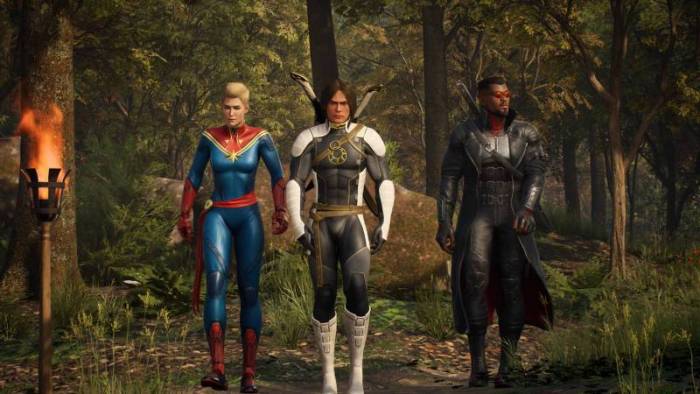
This is probably the review that has taken me the longest to really decide how I was going to explain exactly what this game is, and maybe that’s telling.
I loved certain things about the experience and that kept me going, but others were so grating I wish I could ignore them as they handicapped the other elements of the experience.
Made by Firaxis, the combat has a very slight resemblance to XCOM for sure (their most famous IP) in that you control a squad against overwhelming odds. Each aspect of the core gameplay loop is an exercise of “shades of XXXXX” through and through.
It has deckbuilding elements, ala Slay the Spire, role-playing elements with your party members, ala Dragonage: Origins, real-world “exploration,” ala Dragonage: Inquisition, and resource/time grinds, like a Massive Multiplayer Online game.
If you’ve played any of the above, that’s great, as it’s probably what drew you to this title. However, you need to go into this one checking those expectations at the door because it truly is unlike any game you’ve played; for better or for worse.
As always, a quick shout out to the developers/publishers for granting me a review code and apologies for the delay in getting this published; it’s been a crazy 2023 so far, and this game has a lot of content.
The Marvel’s Midnight Suns Narrative, Cast, and the World
You are known as the Hunter, a warrior resurrected from the dead to combat the forces of your mother, Lillith.
Lillith is aptly named the “Mother of Demons,” so therapy would probably have gone a long way in young Hunter’s early life. You were resurrected after killing her and dying yourself 3 centuries ago, and you are this world’s only hope.
You are joined in a mysterious, mystical Abbey located in Salem, Massachusetts, by a roster of Avengers and Midnight Suns. The Avengers need no introduction, but the Midnight Suns comprise of a selection of Nico the Blood Witch, Robbie, aka young Ghost Rider, Magik, the ruler of Limbo, and the grumpy half-vampire Blade.

Lillith represents a dark god called Chthon, and they are both in the business of corruption, and girl … business is booming.
Their ultimate goal is to bring Chthon back from exile and reshape the earth into an extension of his will. Standard eldritch-being shit. They are supported by the fascist villain group called Hydra, and they are just as sorry as you would expect from the movies.
One of the heroes (probably Spider-Man) even quips that it must get tiring to get beaten up by the good guys so often, and you mop the floor with them through a large portion of the narrative experience.
Speaking of the Marvel movies, the characters you may be familiar with are represented in-game but in a much more simplistic manner. Much of your relationship with them is told through small vignettes, passing conversations, and “hang outs” as you gradually ingratiate yourself into this motley crew.
They all think you’re incredibly sus for a while, but as you spend more time with them, you grow on them. Kind of like a mushroom, the Hunter does turn out to be a pretty “fun guy.”
Building these relationships is actually a concrete progression mechanic that impacts your companion’s abilities. A lot of it can seem forced, especially a the beginning, but I promise you it gets more endearing when you stick with it.
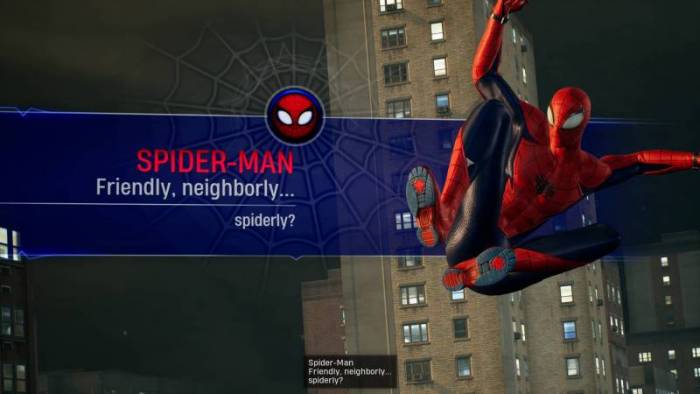
As you gain levels of friendship, these veritable demigods open up about their insecurities, passions, and the like, making you feel like progress has been made as you stare into the gaping sphincter of the apocalypse. I found it strangely comforting that as the world around us collapsed within the Abbey, we just grew closer together.
Yes, I have the capacity to be poetic and sappy…eff off.
Just like your parents, however, I definitely had a preference for who I enjoyed interacting with most. Some characters just didn’t bring that level of connection with me as a player.
Give me the subtle nuance of Magik, the cursed demon queen, struggling with the temerity of her dark destiny, as opposed to the one-dimensional gym advertisement known as Captain America, who is, for lack of a better word, a plank.
He’s inspirational, a great guy, and a superb leader, but he’s also a plank.
Some of the characters are constructed entirely around a single personality trait, and that made trying to care about what some of them were telling me difficult due to this monochromatic nature.
The voice acting is hit or miss, as well. Hunter, in particular, sounds half like a Middle School thespian trying to run for Class President, while at other moments, the emotion in his words rang through reasonably well. It truthfully can be all over the place, but I stuck with it and put it past me for most of the game.
Thankfully the dude was also really hot, so I didn’t mind hearing him chinwag in a really awkward manner.
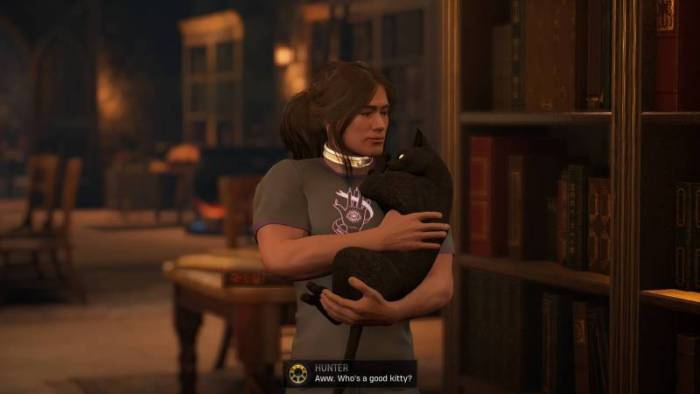
Me, I’m a good kitty UwU
Likewise, the writing oscillated between being cringe and being moving.
There is a delicate balance when it comes to portraying the youthful naivety/exuberance of the Midnight Suns clashing against the arrogant certainty of the Avengers, but sometimes the petulant whining from both camps became too much to bear.
Coming together and putting aside differences in the face of adversity is undoubtedly a notable theme, but good lord. I couldn’t help but rub the bridge of my nose in repulsion at some of the corny shit pouring out of these superhero’s gourds at times, only to be surprised when the dialogue switched tone to be more meaningful and solemn.
Jarring, but the weird juxtaposition sometimes worked in its favor.
This duality aside, one thing is absolutely certain. Tony Stark still remains my least favorite hero across the entire mainstream Marvel landscape due to being such an incorrigible douchebag at all times. Each comment is more grating than the last, the inability to accept fault is childish, and you can tell if he was real, he would have surrounded himself with people that say he’s funny.
I can’t stand him. Apologies, he will be mentioned a few more times in this piece.
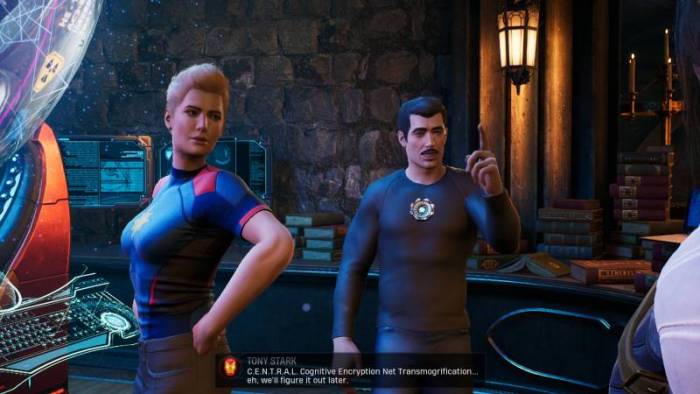
Shut. Up.
During your off time, you’re able to use Hunter to explore the Abbey grounds in search of secrets.
There are barriers obstructing your progress that can be removed by abilities given to you by the old gods of the land. These allow you to unlock doors, reveal hidden paths, purify Chthonic corruption, and break through rocks to give you access to additional resources and collectibles.
Engaging with this world provides you with access to cosmetic chests that predominantly give your roster additional color palettes for their outfits. It’s harmless, and I got some mileage out of it, but it doesn’t actually add that much to the game, in my opinion.
Super Hero Twitter feed must be mentioned, unfortunately. This is the main vehicle in which you get in touch with key team members to do special activities, like a Book Club; and individual vignettes with each team member upon reaching a certain level of a positive relationship.
However, it also is filled with cringe-worthy banter that makes you wonder if the writers ever actually had friends, to begin with.
My advice, check it each day to see if there is a specific purpose, but if not, ignore it. You’ll do your eyeballs a service.
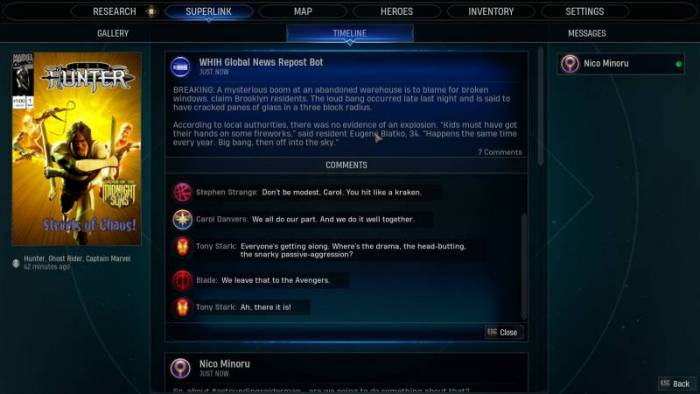
Despite the cringe, the final thing to note is that the ending scene before you head off to face the final mission/battle was actually really moving to me.
The sadness, the desperation, and the camaraderie you’ve built; maybe it wasn’t an Academy Award-winning scene, but it was compelling. It really made me feel like the 68 hours of building these relationships prior ultimately meant something in the end.
The ending battle is also a really fun way to cap off the game, so without spoiling it, I’m glad I got to experience it and hope that you do too.
I will go further and say I’m a bit surprised/bummed they didn’t include a very PG-13 relationship mechanic, as something within me wished the Hunter would find some love and comfort amidst the swirling vortex of his predestined path, but perhaps that was for the best.
Marvel’s Midnight Suns Combat: The Actual Fun Bit
This is the meat of this game, don’t let anyone tell you otherwise.
Combat works in a very unique way that can be described as 3 dimensional Slay the Spire. Each of your heroes that you take into battle has eight cards in their decks that can be drawn into your hand.
Each superhero has its own specialization, and these can allow for some pretty satisfying synergies. Your hand consists of a maximum of six cards that are drawn from the aforementioned pool of your character’s combined 8-card decks. If you have over six in hand, you will not draw another at the start of your turn.
You’re given three opportunities to play an ability per turn, along with the option to reroll a card in hand twice before the various enemies get their chance to rearrange your organs.
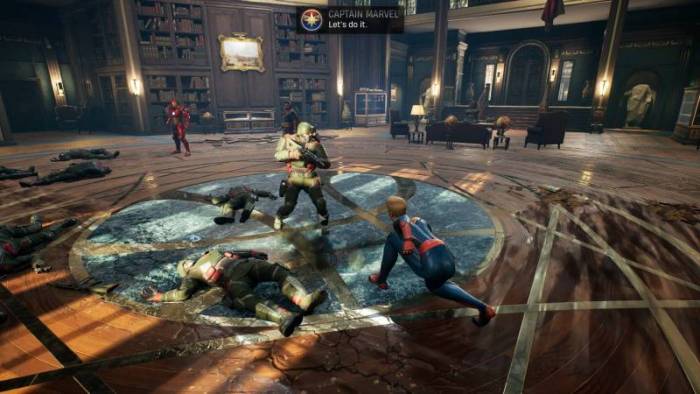
The cards have a wide range of effects that do some truly interesting things, but ultimately I can group them into the following categories: cards that generate currency (heroism), cards that spend heroism, and cards that refund your action point.
Cards that generate heroism are typically weaker in terms of direct damage but can potentially “buff” your team in various ways.
The amount of heroism generated per card play is represented in the bottom left corner of the card. Conversely, in the top left, there will be a number, when applicable, that indicates how much heroism you will spend to activate that ability.
These spender abilities are often much more powerful but are limited in how many you can play based on your heroism in the bank. There is a very simple exchange system, and you can accrue a maximum of 10 Heroism at a time, so spend it if you have it.
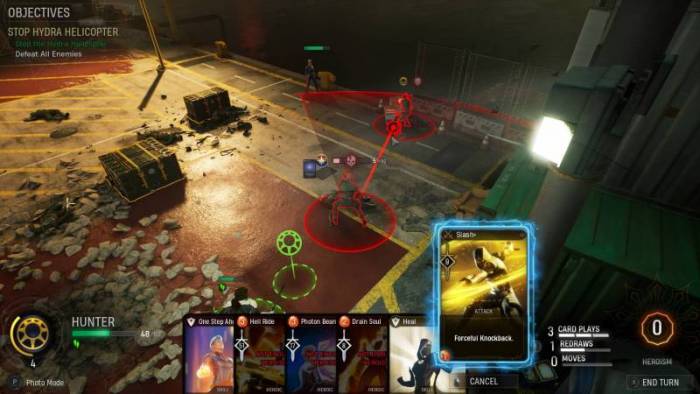
In most card games (because that’s what this essentially is, just with more flourish), a good rule of thumb is you want to maximize your card draw and your action economy. More card draw simply means more options, and action economy refers to eliminating as many targets as you can with the allotted “actions” you have available.
There are predominantly a lot more of them than your team of three, so giving yourself extra chances is imperative to finishing any mission without a character death.
Therefore, when you are building out each deck, while you can specialize the character to perform a certain role, such as being a tank to absorb hits, you always want to make sure your deck is diversified enough that a random draw has a good chance to give you an executable play.

Here’s a great example.
Spider-Man is an absolute menace in this game as he is able to rappel around using the environment to double-fist the forces of Hell with the utmost efficiency using things like exploding barrels. This allows him to take out a lot of enemies at the same time, WITHOUT spending any card plays.
As he is at his strongest when he is using his webs to throw absolutely everyone around the room and vaulting over crates to kick people in the face, but those powerful moves cost heroism.
Therefore, in this 24-card deck, you better have ample ways to generate heroism while efficiently damaging enemies and potentially refunding actions.
Otherwise, you may find yourself with a bricked hand full of abilities you do not have the capability to use. Having cards that are unplayable can be a death sentence because the enemies do not stop coming.
While each character has their own special ability set, they also gain a passive buff as they gain more “friendship” with you. This was really neat and led to some astonishingly deeper gameplay than you would expect.
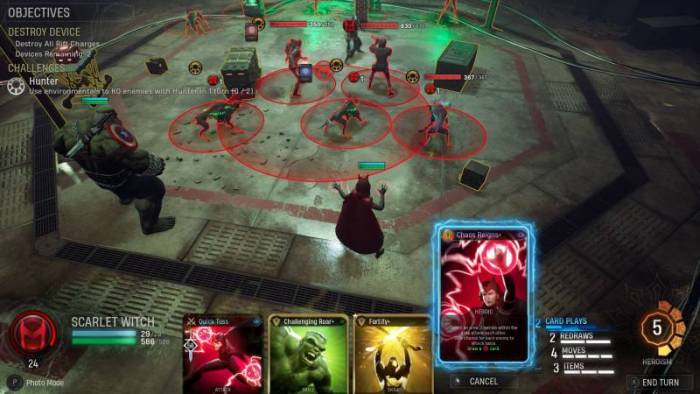
Here are two I found especially fun.
Captain Marvel’s thing is that if you play three of her abilities, she gets a free move called “Going Binary,” which gives her massive buffs to damage and gives her a lot of temporary shielding.
She is also tougher than most and has a passive that gives her a chance upon taking out an enemy to develop a status effect that will automatically allow her to hit back against anyone who attacks her.
She can certainly function as a tank, but I asked myself, “where’s the fun in that?” and decided to opt to use her as the hammer in a whack-a-mole game.
Stacking her deck with “quick” refundable cards, cards that allowed the drawing of additional Captain Marvel abilities, and abilities that allowed her to “taunt” (direct enemy aggression at her) allowed me to quickly make sure that I would consistently be able to play the necessary three cards in a row, activate her binary mode, and use the generated heroism to do a big-time play.
Whoever was left alive would then attack her and, hopefully, get punched in the face automatically for their temerity.

On the flip side, we have Blade, the half-vampire.
Conveniently, a lot of his abilities revolve around taking advantage of the “bleed” status effect, which does damage automatically after an enemy’s turn.
You would actually be shocked at how effective bleed is at removing obstacles; it’s basically an extra attack! Typically in a deck-building game, the older abilities are outpaced by the new ones you get while progressing through the gameplay loop, but Blade may be one of the only characters who can operate just fine with two of his default cards.
One ability called “Make Em’ Bleed” will give his next attack or two automatic bleed triggers, and the other ability is an attack simply called “Strike” that allows him to hit multiple targets at once.
When you use them one after the other, you will be able to place the bleed status effect on up to three separate targets in one fell swoop. What’s more, his passive ability likewise provides each of his attacks with a chance to trigger an extra bleed status on an enemy.
At his best, Blade is able to cause widespread attrition damage to multiple targets with minimal investment; and that’s incredible.
Speaking of enemies, the enemy types are pretty varied, but they — like the cards — can be simplified down into a few categories: things that die in one hit, things that don’t, and mini-bosses.
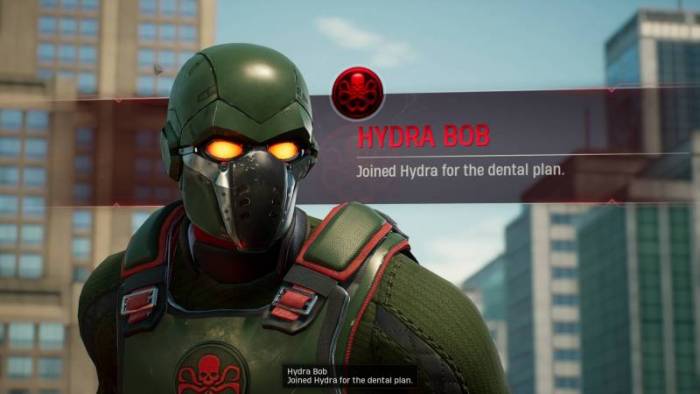
I’ll admit this was kind of funny
You’ll find out pretty quickly that trash-tier mobs are the ones that you should try to take out with a card that regenerates an action on KO (dubbed “Quick” cards). For things that don’t die in one hit, you’ll have to be a bit more clever, with environmental hazards, combinations, and/or your stronger abilities being necessary to stop them from outpacing you.
It is my assessment that maximizing the enemies that could potentially net you an extra action is by FAR the most important part of each turn. Reinforcements stream in for at least two to three turns after a mission starts; one of them will typically be one of these types of fodder.
It becomes up to you with what combination of attacks would be the best to do the most harm. It helps to consider these “freebies” as part of the resources available to you.
Mini-bosses are some of the most fun “wrench in the machine” fights I’ve personally experienced in recent memory. I distinctly remember one instance where I was struggling to deal with an onslaught of reinforcements only to have a supercharged Sabretooth (psychotic mass-murdering mutant) join the party.
There are several mini-bosses in the game, and in their introductory missions, you will have to knock them out twice before they stay down for good. When they pop up uninvited in future scenarios, you only have to kick them in the nuts once.
Thank god, though, because it’s always a clusterf*** when they show up.
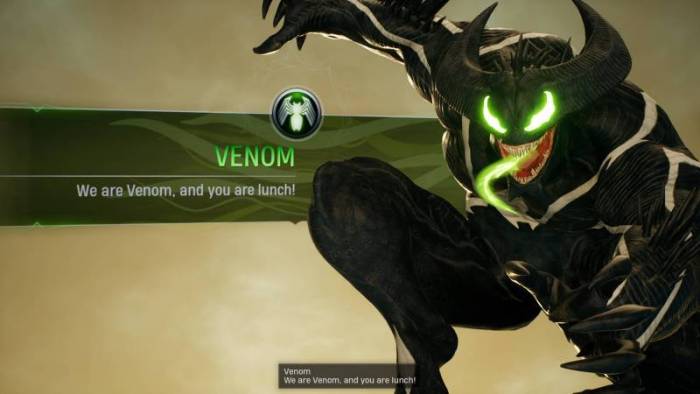
Very much like your heroes, these supervillains have different abilities, and they all pack a wallop.
Sabretooth’s, for example, is that he gets to act “out of turn” after a certain number of cards are played so he can KO one of your heroes right in the middle of your plan.
Similarly, Fallen Venom will sometimes activate an ability that makes touching him result in a hero getting trapped and unusable until released.
When they drop into the party, you best make sure you eliminate them with extreme prejudice before they do too much damage. They also get two actions per turn instead of just one and can easily send a mission careening out of control.
You are also allowed to “move” a character once per turn by default around the battlefield. This is so you can position yourself to take advantage of an environmental hazard. Should that be too complicated, you can also opt to chest bump an enemy like an errant pinball into other objects to some harm.
In order to use the hazards on the map (oil drums, scaffolding, eldritch portals, etc.), you must expend heroism, so make sure you have some saved up.
Another fun mechanic is that as you level up your bond with the heroes on the team as a whole, you get access to powerful “it takes two to tango” moves that do massive damage. These come with an animation of two team members absolutely whaling on someone, and if leveled up enough, they provide an extra effect as well.
These can only be used once per mission, but at the right time are essential.

Like most card games, gathering more experience with a particular “deck” affords you more opportunities to access higher-quality cards, and you will quickly figure out which hero you like to use the most.
I would recommend making sure that each of your characters at least has an upgrade of their basic cards because you may need to use them in an emergency should your A-Team be out of commission.
Each hero’s true ultimate ability is hidden behind a specific challenge that can only be unlocked if you reach their maximum Friendship level. More on that in the next section. It’s helpful to have these as well, so be prepared for some grinding to make sure your team is equipped properly.
The Hunter develops a little differently.
You get cards the same way as everyone else through “coils” after a mission, but you also have a “morality meter” that extends from “dark” to “light.” Based on your dialogue, choices, and abilities you use in combat, this meter will skew one way or the other.
It’s not overly complicated, but the more affinity you develop with a particular side of the scale unlocks new abilities as you go along. It’s pretty cool, even if there was very little nuance with the distinction between “dark” and “light” actions.
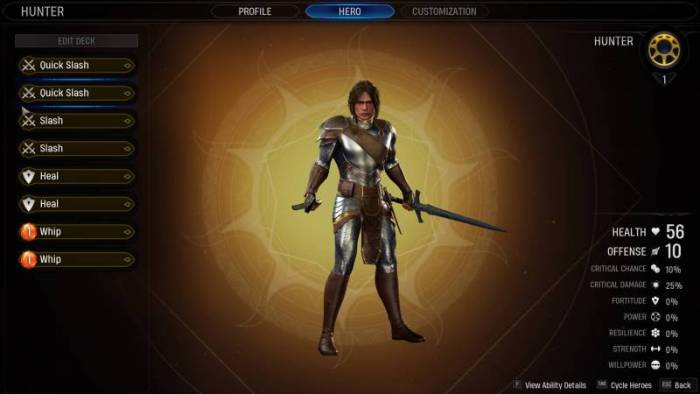
The “light” abilities and actions were typically more uplifting/supportive and “safer.” The “dark” abilities and actions were a bit stronger but also came at a cost (like discarding other cards in your hand) and made you sound like a dick in conversation.
Difficulty Toggling is available after each mission, where enemy numbers, health, damage, and more increase as you toggle the setting higher. This is a welcome addition to the game because not only does it provide you with extra rewards, but it also prevents the game from getting too stale.
Your heroes will level up to a point where enemies no longer pose a threat at standard difficulties; utilizing this option keeps the tactical element fresh. It also gives you more “gloss” to purchase cosmetics for your team, which leads nicely into…
Marvel’s Midnight Suns Progression and Subsequent Mechanics: Farming, Farming, Farming
As much as Firaxis and 2K want you to believe, this is not supposed to be the meat of the game, don’t let anyone tell you otherwise. Nevertheless, buckle up; it’s going to get confusing.
First, raw materials. There are a lot of resources and interactable collectibles you can acquire that will enable certain functions in-game.
I’ll list them out in an attempt at brevity.
*Gamma Coils: The means by which you collect new cards based on who was on a mission with you to acquire them; 3-5 depending on upgrades and unlocked by Tony Stark. Every mission gives you one. They can give you duplicates of abilities you already have, but you can combine duplicates to make upgraded versions of the ability.
*Artifacts: Secondary mission reward that opens up to find a magical object that can be turned into other resources and some essence for crafting. These are unlocked by Doctor Strange and increase your research level to unlock upgrades for the Abbey.
*Credits: Secondary mission reward that can be used to pay people to spar with you for experience and construct Abbey upgrades researched with artifacts.
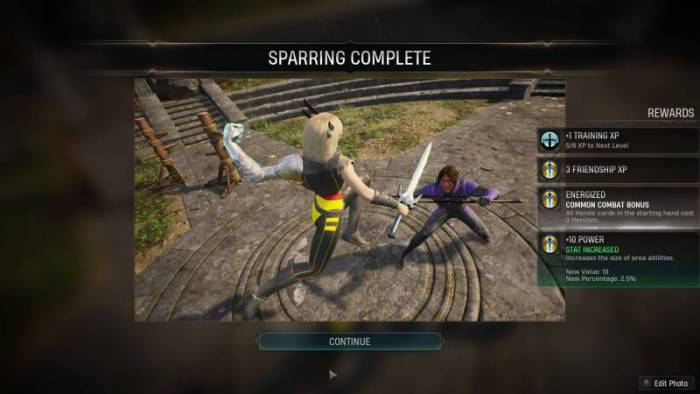
*Essence: Resources that can be expended to upgrade your various cards based on the corresponding denomination of “Attack,” “Skill,” or “Heroic.”
Intel Caches: Secondary mission reward that can be decrypted at C.E.N.T.R.A.L (XCOM fans: if ya know, ya know). Yields additional missions that take place off-screen that reward additional cards to the hero who completes them.
Herbs/Reagants: Things you can pick up by exploring the Abbey grounds to throw in a cauldron and brew up in-battle items.
Collectibles: Knick knacks scattered across the Abbey grounds that offer a cosmetic when a set is completed.
Gifts: Things you can buy, craft, or find to give to your team members to boost friendship gains.
Gloss: Mission reward that allows you to buy costumes, headgear, and to upgrade Hunter’s room.
I’m sure you understand what I’m getting at that this is a lot of stuff to spend in an overworld and, therefore, a lot of stuff to collect.
The first four with an asterisk are essential, as they are necessary to move the main story along.
You will always get a coil after a mission, but you will only ever be able to get one additional secondary critical resource at a time. This means you’ll likely have to continue to grind missions to get the necessary amount of resources of a particular type to progress the narrative.
If you don’t have enough credits to build the plot-device machine nor the appropriate research level to access it, tough luck! Better get to collecting credits and artifacts!
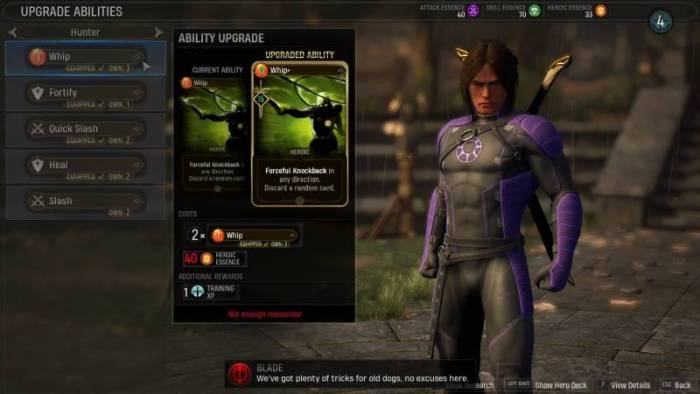
Now, in addition, you can also progress in terms of your “friendship level” with the team. This is just as important, but it can also be just as tedious.
With the exception of the Hulk, each character has an individual “friendship gauge” that rises and falls based on their actions/interactions.
Ways to increase it include saying something they appreciate in dialogue, fulfilling a request for them, sparring with them at the training yard, hanging out with them after a mission, and giving them a gift they enjoy. Going on a mission with Hunter will also increase the friendship experience.
“Why do we care?” you may ask.
Each level of friendship provides benefits. For example, at level 2, you get access to each hero’s unique passive ability. This meter also allows you to add those extra special effects to the “takes two to tango” combination abilities that do heaps of damage in battle.
These are so crucial to making each hero seem unique and effective with their appropriate ability set that it’s borderline mandatory to do them.
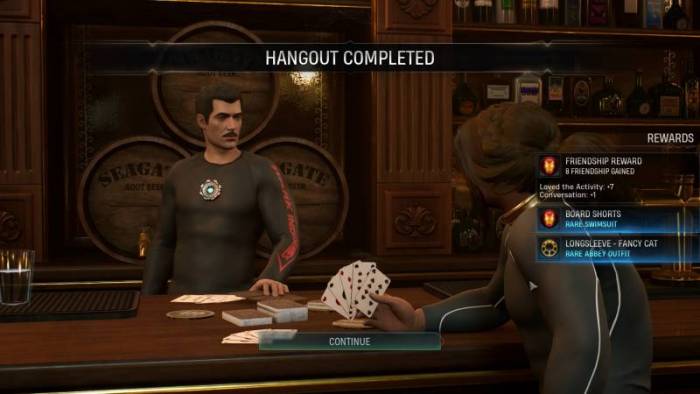
Much to my amusement, sometimes you will unlock extra clothing item options for the Hunter as you get more chummy with some people.
I distinctly remember Tony Stark getting access to new board shorts to use in the Abbey pool, and the concept absolutely cracked me up.
As you upgrade your various friendship levels individually, the overall Team Friendship rank will also increase, and that gives you benefits such as extra “takes two to tango” cards in your combat deck, as well as valuable resources.
Reaching a maximum friendship rank with someone enables you to undertake a special challenge that unlocks their most powerful ability upon completion. These moves are really good, so you’re heavily incentivized to get them, along with a snazzy legendary outfit.
Oh, and did I mention that you can also build up your camaraderie with Charlie, your faithful hellhound?
If you find her and pet her every day, you get some gloss and other resources. She will also level up so you can use her around the Abbey grounds in specific arena missions or call her into battle.
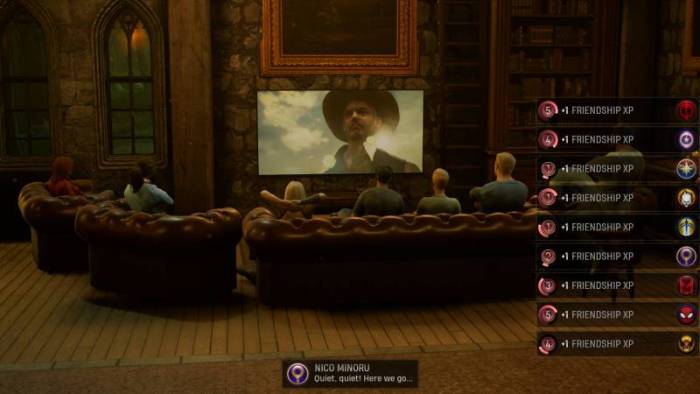
There’s a lot going on, to be sure, and I didn’t touch on absolutely everything. It can be fun to engage with all these various doodads, but I felt that there were better uses of my time rather than collecting mushrooms or trying to make Wolverine like me enough to unlock his ultimate ability.
This leads me to the biggest issue with the game.
Criticism of Marvel’s Midnight Suns
What this game struggles with, in my assessment, is a pacing issue. If I was feeling more cavalier, I’d say the game has zero appreciation of the player’s time.
The first 10 hours and the remaining 59 hours both struggled in different ways to make it seem like I was playing the game at its most fun.
Up til the 7-10 hour mark, I quite simply was so inundated with forced dialogue and lengthy tutorials that I honestly almost gave up.
There are a lot of mechanics and overworld progression to get through, but none of them are overly complex. For example, it doesn’t take a genius to understand that in order to get new cards in your deck, you have to draft them from canisters received as mission rewards.
Thankfully, in case you’re really stupid and missed it, you have to watch a whole cut scene filled with the aforementioned stellar levels of banter between your teammates, talking about how these are vital to your efforts in the demon war.
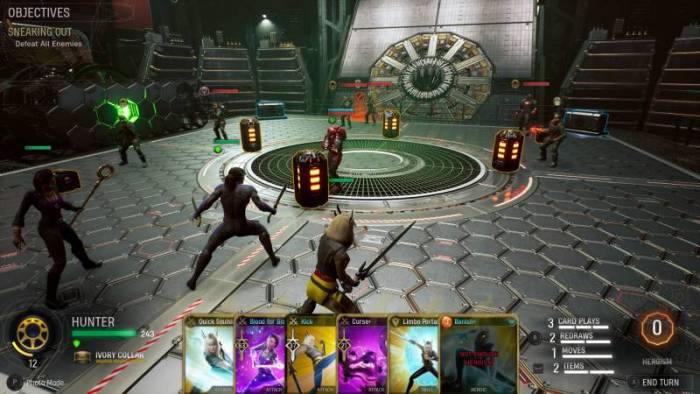
Likewise, despite being filled with maggots for a few centuries, if I shook the cobwebs off your great-great-grandpa and gave him a bit of Red Bull, he’d probably understand that getting an intel cache from an enemy base would require the allocated decryption computer to access it.
It’s not an alien concept to grasp, but you still have to go through a scripted dog and pony show explaining the importance of the device and how Tony Stark is struggling to connect the arcane with the mundane. Seemed aggressive, in my opinion, to subject players to that.
None of these instances are super egregious individually, but as a combination of many subsequent hours of this experience, I found myself rolling my eyes in exasperation as the flow of the game was once again paused by another scripted sequence or tool tip.
Now before I continue the rest of my critique, I’m going to reiterate it gets SO much better if you just power through this first initial stage.
My mood dramatically shifted from barely stomaching the experience to tentatively enjoying it. That being said, throughout the entirety of my time with it, the game is difficult to play for more than a few hours at a time.
Here’s why: By far, the best part of the game is the combat missions; it’s no contest. Laying the hurt on fascists and demons is great. The animations are satisfying (albeit laggy occasionally), the art is tight and colorful, and the heroes felt different enough to be uniquely fun. What’s more, you get to do truly awesome things like shoot laser beams, breathe hellfire on people, and control an angry Canadian.
But why the hell do I not get to do that more?

Gesundheit
You have a roster of super-beings that are the main attraction of this game, but you are only allowed to perform a single mission with three characters per day. Each mission may take 20-45 minutes, depending on the structure, and while you may be salivating for the next one, you have to head back to the Abbey and proceed to the next day before playing it.
But wait! Don’t forget that in between missions, you have to run the gamut of little tasks to make sure you maximize all the little progression meters necessary to keep yourself at pace with the forces of evil. Otherwise, they may outstrip you!
An average day may go something like this:
- Wake up and head to the Forge, listen to Tony Stark’s inane joke, and access your new moves by opening a coil.
- Check with Doctor Strange if you have an artifact to unlock or research to commission.
- Go find your dog and give them a pet to get some currency and XP.
- Go to the training yard and spar with a teammate and upgrade an ability if you can.
- Meander towards the computer to analyze an Intel Cache and execute the missions that are produced from this.
- Head to the war table and SELECT A MISSION.
- DO THE MISSION with 3 out of your 12 guys.
- Head back to the Abbey and engage in a “hangout” with someone from your mission if available.
- Go to sleep.
This sequence is easily another 20-30 minutes, and I didn’t even include any exploring of the Abbey grounds nor activities like engaging with ambient conversations that will net you friendship gains for improved team member abilities.
These are “optional,” but each of these activities provides a small tangible cumulative benefit to your team, and you’ll need them.
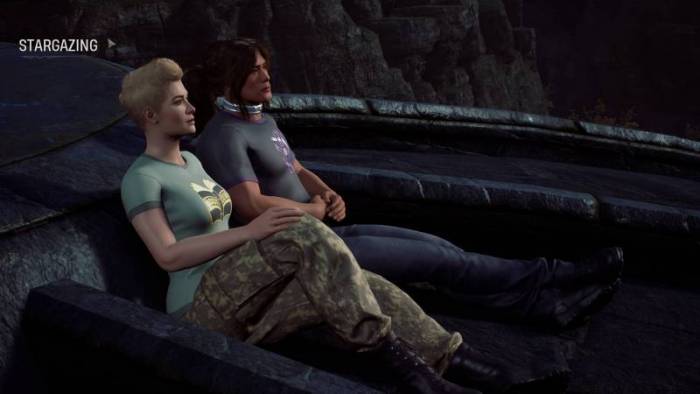
I’m of the opinion that all that background shit for a single excursion a day is a very strange balance to be had.
I would have loved for there to be a way to send perhaps even two missions in one day so that half your squad could progress at once instead of the relative snail’s pace that currently exists.
What’s more, you are, in fact, unable to do main story missions back to back unless you perform a side quest in between. You basically have to go through an entire additional cycle, and just because the mission is available doesn’t mean you can actually play it.
You may not have the appropriate resources to upgrade/research/conduct the tasks you need to progress, so you have to play another side quest to get the stuff you need.
All of this runs parallel to the fact that if your team isn’t leveled/equipped with higher tier abilities, meaning you have to interact with everyone; boost friendships; and take them on missions to get abilities, they won’t survive late-game encounters unless you crank the difficulty down.
To me, all this seemed like a way to artificially bog down the game, and there’s simply too much fluff.
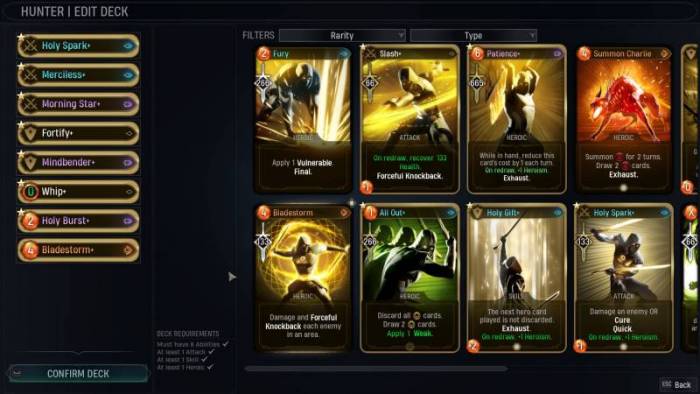
Not to mention all these abilities to manage
While I did end up enjoying my time as I played the game more, I can’t decide if that was Stockholm syndrome, me buying into the drama, or me getting used to the pacing.
I think for future games, they need to tweak this balance. You should emphasize the parts that are the most fun and impactful in your gameplay loop, which is the card battler. What a shocking and controversial take.
The game also had several polish missteps that didn’t necessarily tarnish the experience but certainly made for some awkward moments.
For example, every few missions, the game would start to really lag and stutter in terms of performance. NVIDIA GeForce Experience recommended my settings to be at the highest, but upon selecting that, I was forced to drop it down to “High” to improve the fluidity.
It should be mentioned that the latest graphics driver makes some updates to smooth out these issues, so your experience may differ from mine.

My computer isn’t the epitome of cutting-edge anymore, but it’s still way in the top percentage of equipment, so this was a bit interesting to see. The game functioned much better after I dropped the settings, and at the end of the day, “High” settings were still sufficient, in my opinion.
Another prevalent bug is characters falling through the floor of the map. On certain maps, a particular character would just drop like a stone, meaning that in order to interact with them, you’d have to remember their exact positioning on the field.
This doesn’t impact the AI, of course, so it gave an enemy playing this game of hide and seek a leg up because they can attack you while you potentially are unable to get a bead on them to retaliate.
The third optimization/bug that was most obvious was the incredible lag upon startup when I first installed the game.
Upon research, I discovered that this was a common problem amongst users and was theorized to be caused by the 2K launcher that automatically popped up upon starting the program.
There is a way to disable it by fiddling with some of the launch path settings on Steam, and this did resolve the choppy startup experience, but I shouldn’t have needed a crowd-sourced method to fix it.
I’m sure these aren’t the only one suboptimal moments, and again, they were manageable, but for a game of this price, you’d hope there would have been a more seamless experience.
By the time you read this, they may have patched this out, but this was my experience at the time of playing it.
Plenty of other folks have complained about the game’s use of Denuvo Anti-Tamper software, so I’ll refrain from laying into that as well.

Conclusion
Marvel’s Midnight Suns is a truly unique experience that is marred by having the player focus on the wrong things for way too long.
The card battling is great, the superheroes are flashy, and there is enough charm here that it kept me entertained for 70 hours. This is not a “one and done,” as they are releasing additional DLC content for this game starting with “The Good, The Bad, and the Undead,” which introduces a new hero and story missions. It was released on January 26th, 2023, and when the full season pass content comes out, I plan to do a follow-up review of that.
In classic Marvel fashion, the post-credits scene tees up a sequel featuring one of the most over-the-top villains in Marvel history, Doctor Doom.
Despite all that I felt could have been done better, you better believe I’m looking forward to the next one. That’s why Marvel’s Midnight Suns gets a 3/5; they’ve struck gold on the core mechanics, and the game has some truly unique qualities. It just needs to be refined.
Buy it if you want to have a bit of fun unleashing classic characters on the forces of evil and some spectacular story moments or if you like customizable deck builders.
Marvel’s Midnight Suns starts at $59.99; it is available from Steam, Epic, Game Stop, Amazon, and other retailers.
Developer: Firaxis Games
Publisher: 2K
Source: Manufacturer supplied review sample
What I Like: Fun card-based combat; A varied cast of characters; Gorgeous art direction
What Needs Improvement: The pacing of the game isn’t optimal; There are performance blips and bugs; The mind-numbing tutorial phase
